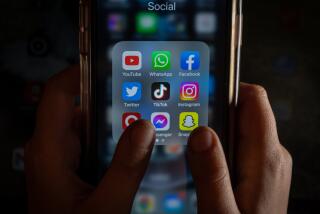High-Tech Users Told Not to Be Driven to Distraction
- Share via
WASHINGTON — Federal highway safety regulators, in their first official warning about the pitfalls of a wireless society, recommended Tuesday that drivers refrain from talking on cell phones, reading e-mail or surfing the Internet.
The National Highway Traffic Safety Administration’s concern about mounting driver distraction comes as industry is developing vehicles with even more high-tech gadgets. On the drawing board are cars that will receive music videos, voicemail and traffic updates via a wireless link that could also transmit automatic distress calls and medical data in emergencies. Meanwhile, drivers are already juggling cell phones, Palm Pilots and other portable devices.
“Drivers should not talk on the phone or use other devices while their vehicles are in motion,” said Rosalyn Millman, head of the traffic safety agency.
While pledging to make that the agency’s official advice, Millman said that much greater public and private effort will be needed to address the implications of a connected society for the nation’s streets and freeways. The agency has power to set vehicle safety standards but has no jurisdiction over portable phones, the regulation of which largely remains a state and local matter.
“The plethora of gadgets and gizmos that are being designed into vehicles may be the much bigger threat of tomorrow,” said Millman. “Will we learn about those risks and deal with them expeditiously or will we wait for rising numbers of deaths and injuries?”
A new survey by the traffic safety agency shows that 44% of drivers have phones in their cars or carry portable cell phones when they drive, while 7% have e-mail access and 3% can send and receive faxes.
Speaking for auto makers, Vann Wilber, director of vehicle safety for the Alliance of Automobile Manufacturers, said that his industry is willing to fund more research into high-tech distraction and to draft voluntary safety guidelines for the design of built-in systems.
“The goal is to allow the customer to have a safe communications system while limiting distractions while driving,” said Wilber. For example, incoming calls might be automatically placed on hold if sensors detect a complicated traffic situation, such as high-speed travel with little separation between vehicles.
But Charles Eger, a regulatory affairs expert for cell phone giant Motorola, suggested that the traffic safety agency’s new recommendation goes too far. Motorola advises customers not to conduct complicated business negotiations or emotional personal conversations while driving, but “I don’t know of any research that would support a flat-out ban,” Eger said.
The cell phone industry’s Tom Wheeler pointed out that mobile phone users can report accidents and criminal behavior quickly. He said that education in safe use is the answer.
“Talking to your divorce lawyer late at night on a twisting road when it’s raining is not the right call,” said Wheeler, president and chief executive officer of the Cellular Telecommunications Industry Assn. “Calling your wife to say you’re running late is OK.”
However, at a daylong forum sponsored by the agency, safety experts and academics presented new data that show using high-tech devices is more distracting than, say, trying to find the rare classic jazz station on the FM dial. The meeting was punctuated by the occasional ring of cell phones, although those in attendance had been asked to turn them off.
According to several studies, even hands-free cell phone conversation can reduce a driver’s concentration. Research shows that drivers who are talking on the telephone are less likely to check their mirrors or fully scan the roadway ahead. Moreover, the ingrained impulse to answer the phone on the first or second ring can cause problems.
Typically, distracted drivers crash into the rear of a vehicle ahead of them, drift into another lane and get sideswiped, or leave the roadway and strike some object such as a tree.
“Hands-free is not risk free,” said Millman. “NHTSA research and other research clearly show that we must be concerned with manual distraction, visual distraction and cognitive distraction. Hands-free . . . will not affect or reduce cognitive distraction.”
According to crash investigator Frances Bents, who has studied numerous accidents involving cell phone use, there is a crucial difference between conversation with a passenger and talking on the phone with someone who is not present.
“A passenger in the vehicle is aware of the driving situation,” she observed. “The passenger may stop talking if there is a problem to deal with. A passenger can also serve as a second set of eyes.”
Thomas Dingus, director of the Virginia Tech Transportation Institute, presented test findings that accident risk varies according to the type of high-tech task a driver is attempting.
For example, Dingus found that a complex high-tech task--such as dialing a 10-digit number on a hand-held phone and then navigating a computer answering system--results in a fivefold increase in crash risk than fiddling with the radio to find a station.
However, a relatively simple task--such as following verbal instructions from a satellite navigation unit in a car--is about as safe as tuning the radio.
“Crashes will increase if improperly designed systems are deployed in large numbers,” Dingus said.
A 1997 New England Journal of Medicine study of 699 drivers with cell phones who were involved in crashes found that the risk of getting into an accident was four times greater when the phone was being used.
The traffic safety agency estimates that 1.6 million crashes a year--25% of all accidents--involve distraction. However, no one can say for sure how much of that can be attributed to use of phones and other gadgets. The government’s extensive auto safety databases depend on information gathered by police, and only two states--Oklahoma and Minnesota--use a form on which an officer can note cell phone use.
“Police reports are a weak link,” said traffic safety agency statistician Joseph Tessmer. The agency is urging states to agree on a simple, standard method of reporting information on high-tech distractions.
According to crash investigator Bents, legislation to limit cell phone use in cars was introduced in about half the states this year. “The industry lobby has successfully argued that every state already has careless-driving statutes on the books,” she said. Two localities--Marlboro Township, N.J., and Brooklyn, Ohio--have enacted laws forbidding the use of hand-held phones while driving.
Cell phone industry officials said that driver education, not laws and regulations, is the key to improving safety. “Barring cell phone use for consumers is not going to get at the issue,” said Norman Sandler, director of global strategic issues for Motorola. “It may not be realistically enforceable.”
But Millman said it is a mistake to assume that “the genie is out of the bottle” and nothing can be done. “This problem will grow larger and more complex. Waiting only increases the difficulty we will have solving it.”
Driver distraction has been a concern since the earliest days of the automobile. Indeed, even the radio was once regarded with suspicion.
“A grave problem . . . has all the motor vehicle commissioners of the Eastern states in a wax,” said a 1930 Farmers’ Almanac article. “It’s whether radios should be allowed on cars. Some states don’t want to permit them at all--say they distract the driver and disturb the peace. The manufacturers claim that the sound of Rudy Vallee’s voice is less disturbing than back-seat conversation.”
More to Read
Sign up for Essential California
The most important California stories and recommendations in your inbox every morning.
You may occasionally receive promotional content from the Los Angeles Times.













